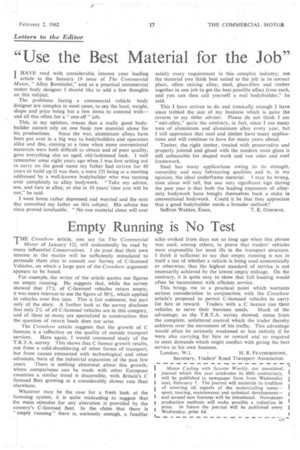Empty. Running is No Test
Page 61

If you've noticed an error in this article please click here to report it so we can fix it.
THE Crossbow article, you say (in The Commercial Motor of January 12), will undoubtedly be read by 'many influential Conservatives. I do /rust that their own interest in the matter will be sufficiently stimulated to persuade them also to consult our Survey of C-licensed Vehicles, on which a large part of the Crossbow argument appears to be based.
For example, the writer of the article quotes our figures on empty running. He suggests that, while the survey showed that 17% of C-licensed vehicles return empty, it was more relevant to use the figure of 50%, which applied to vehicles over five tons. This is fair comment, but part only of the story. A further look at the survey discloses that only 2% of all C-licensed vehicles are in this category, and of these so many are specialized in construction that the question of return loads does not arise.
The Crossbow article suggests that the growth of C licences is a reflection on the quality of outside transport services. Here again, I would commend study of the T.R.T.A. survey. This shows that C licence growth results, not from a cold-shouldering of other forms of transport, but from causes connected with technological and other -advances, born of the industrial expansion of the past few years. There is nothing abnormal about this growth; where comparisons can be made with other European countries a similar trend is discernible, with Britain's C licensed fleet growing at a considerably slower rate than elsewhere.
Whatever may be the case for a fresh look at the licensing system, it is quite misleading to suggest that the main stimulus for any alteration is provided by the country's C-licensed fleet. In the claim that there is "empty running" there is, curiously enough, a familiar echo evoked from days not so long ago when this phrase was used, among others, to prove that traders' vehicles were responsible 'for most ills in the transport structure. I think it sufficient to say that empty running is not in itself a test of whether a vehicle is being used economically or otherwise; that the highest standard of service is not necessarily achieved by the lowest empty mileage. On the contrary, it is quite easy to show that full loading would often be inconsistent with efficient service.
This brings me to a practical point which warrants serious consideration in conjunction with the Crossbow article's proposal to permit C-licensed vehicles to carry for hire or reward. Traders with a C licence run their vehicles to serve their business needs. Much of the advantage, as the T.R.T.A. survey showed, stems from the complete, unfettered control which the trader thereby achieves over the movement of his traffic. This advantage would often be seriously weakened or lost entirely if he were also carrying for hire or reward and so required to meet demands which might conflict with giving the best service to his own business.
London, W.1. H. R. FEartlEasToNE, Secretary, Traders' Road Transport Association.
— — — — — — — — — — — Motor Cycling with Scooter Weekly, our associateda , journal which this year celebrates its 60th anniversary, I I will be published in newspaper form from Wednesday I next, February 7. The journal will maintain its tradition of covering all aspects of the motorcycling scene— I sport, touring, maintenance and technical development— and several new features will be introduced. Newspaper a production methods will make possible a reduction in I price. In future the journal will be published every I I Wednesday, price 6d. _




























































































































